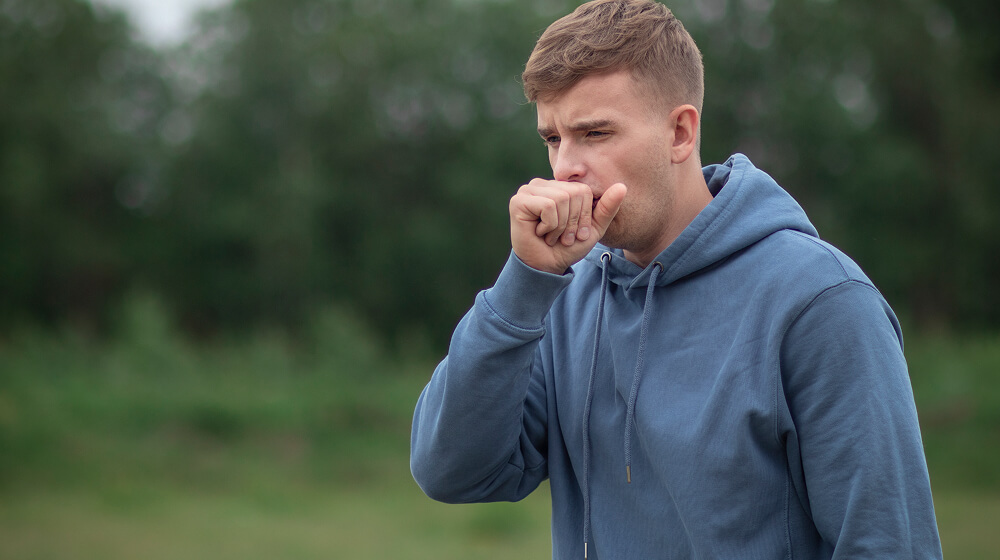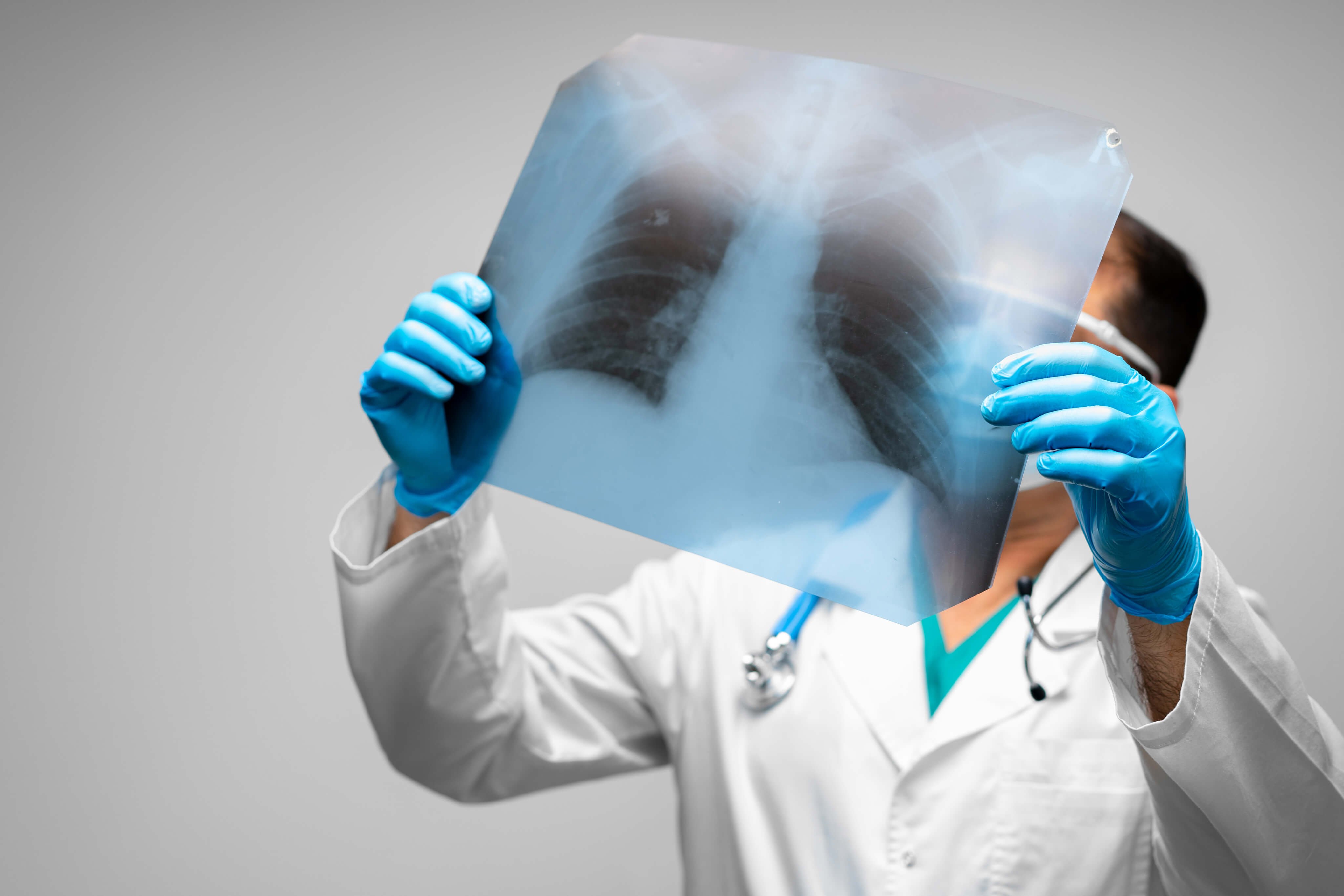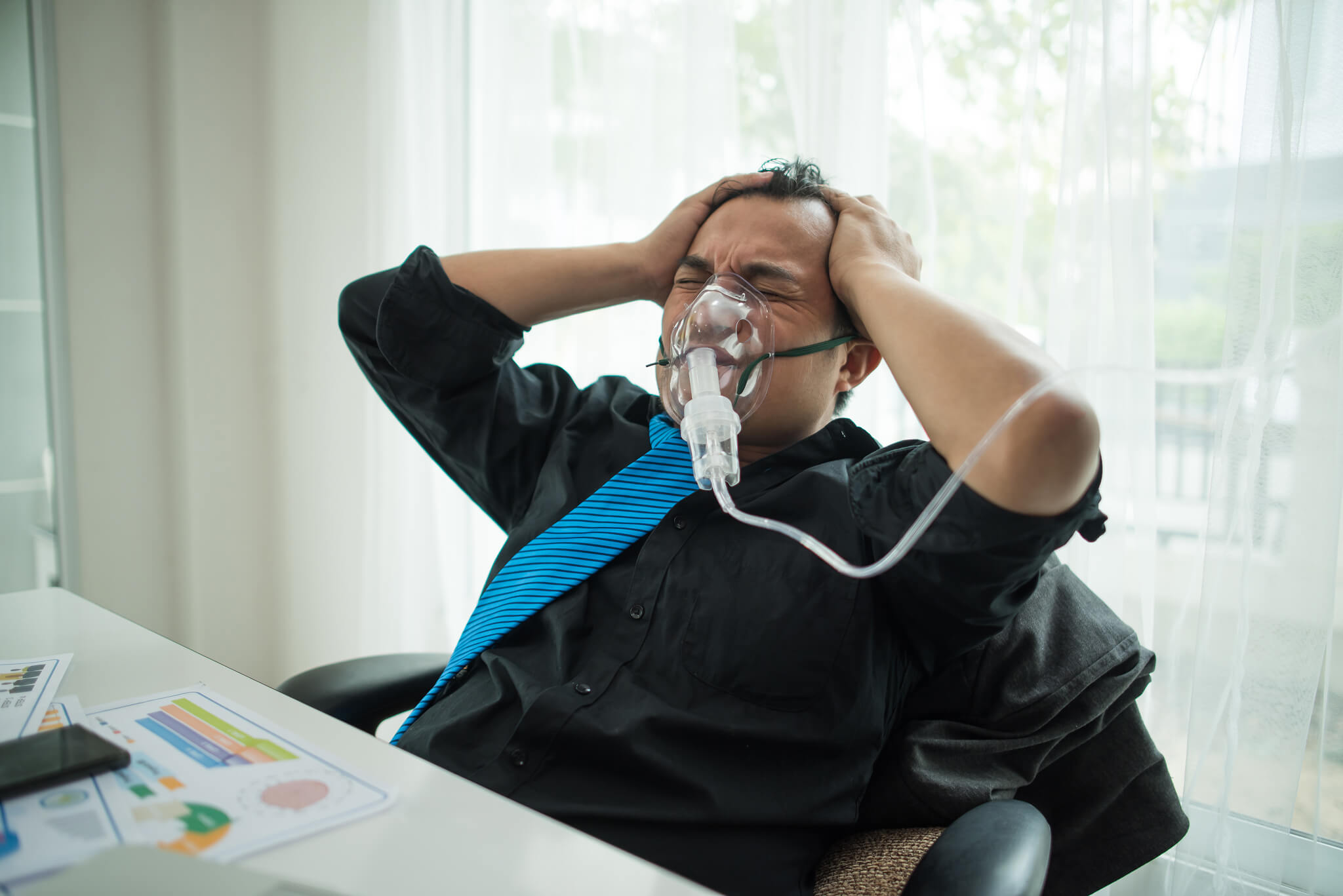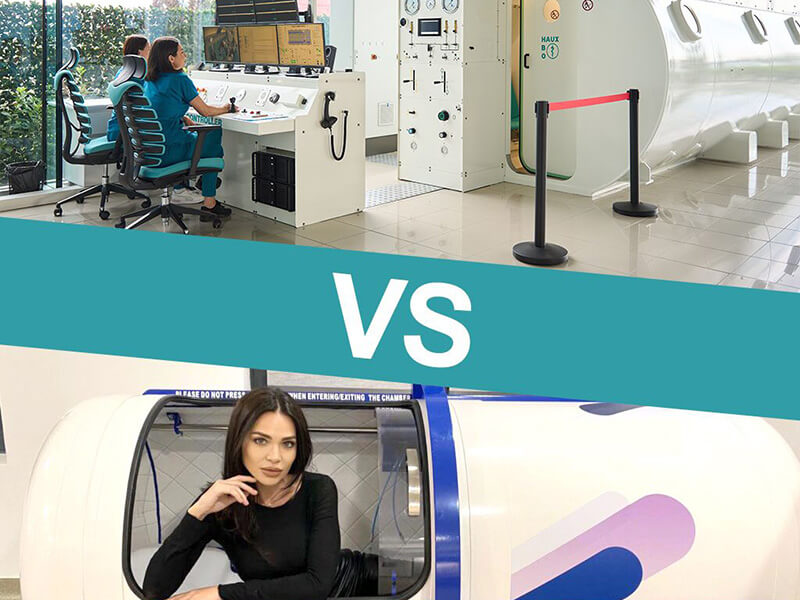
Article reviewed by: Dr. Sturz Ciprian, Dr. Tîlvescu Cătălin and Dr. Alina Vasile
Article updated on: 17-06-2025
Lung and respiratory system diseases
- The most common respiratory diseases
- Occupational lung diseases
- Rare lung diseases
- Benefits of hyperbaric oxygen therapy for lung conditions
- Tips for prevention, lifestyle and the importance of recovery
The lungs and respiratory system play a vital role in oxygenating the body, but they are vulnerable to a wide range of diseases. Lung conditions vary from acute infections like pneumonia to chronic diseases like asthma or COPD (chronic obstructive pulmonary disease). These respiratory diseases are very widespread and represent a major cause of suffering and mortality globally. For example, COPD is the fourth leading cause of death worldwide, causing 3.5 million deaths in 2021 (approximately 5% of total deaths). Beyond the health impact, lung diseases affect patients' quality of life, making daily activities like walking, climbing stairs, or even prolonged speaking difficult.
The most common respiratory diseases
Common respiratory diseases include both chronic and acute conditions. What they are, how they manifest, what their causes and impact are, are questions whose answers are the first step toward correct diagnosis, appropriate treatment, and a fulfilling life, free from fear of a new disease attack.
Chronic obstructive pulmonary disease (COPD)
COPD, also known as chronic obstructive pulmonary disease, is a progressive condition characterized by persistent limitation of airflow through the airways. Practically, COPD is an umbrella term that includes chronic bronchitis (chronic inflammation of the bronchi, with persistent productive cough) and pulmonary emphysema (destruction of alveoli and loss of lung elasticity). Patients with COPD usually complain of breathing difficulties (dyspnea), chronic cough (usually with sputum), and fatigue. Over time, these symptoms worsen, and acute episodes of exacerbations (sudden worsening) can be dangerous and often require hospitalization.
The main risk factor for COPD is cigarette smoking. Over 70% of COPD cases in developed countries are attributed to smoking. Prolonged exposure to air pollution (including smoke from homes caused by burning biomass or coal) and occupational exposures to dust, smoke, and chemicals can also contribute to COPD development. A rare genetic factor, alpha-1 antitrypsin deficiency, can predispose to emphysema at young ages, but the vast majority of COPD patients have a significant history of smoke exposure.
COPD is a major public health problem. Globally, it has become the fourth leading cause of death. According to the World Health Organization, in 2021 the disease caused 3.5 million deaths (approximately 5% of total deaths globally), which highlights the severity of its impact. Also, COPD is responsible for significant loss of quality of life and work capacity, being the eighth leading cause of years lived with disability globally. In Romania, COPD prevalence in adults is estimated around 8-9%. An epidemiological study from 2012 found a prevalence of 9.3%, but less than half of the cases were diagnosed, a sign that the disease is underdiagnosed. This means many people live with COPD without knowing it, attributing symptoms to aging or "lack of physical fitness."
You should know that COPD cannot be cured, but symptoms and disease progression can be improved through treatment and lifestyle modification. Smoking cessation is the most important measure; even after many years of smoking, stopping smoking slows lung function degradation and reduces symptom severity. Medical treatment includes bronchodilators (inhaled medications that dilate airways), inhaled corticosteroids (to reduce inflammation), oxygen therapy in advanced cases, and participation in pulmonary rehabilitation programs. Pulmonary rehabilitation is a supervised program of exercises, nutritional counseling, and education that has been proven to considerably improve exercise tolerance, dyspnea, and quality of life in COPD patients. Additionally, annual flu vaccination and pneumococcal vaccination are recommended for COPD patients to prevent respiratory infections that can cause severe exacerbations.
Bronchial asthma
Asthma is a chronic inflammatory disease of the airways, characterized by bronchial hyper-reactivity: the bronchi narrow episodically under the influence of different triggering factors, leading to attacks of wheezing breathing, cough, chest tightness sensation, and breathing difficulties. Unlike COPD, airway obstruction in asthma is reversible (spontaneously or with treatment). Asthma can appear at any age but is the most common chronic disease in children.
Globally, it is estimated that asthma affects over 300 million people. WHO data shows that in 2016 there were about 339 million cases and nearly 420 thousand deaths attributed to asthma. Most asthma deaths occur in elderly adults and in low-income countries, where access to medications and care is limited. In Romania, asthma prevalence is estimated at approximately 4–5% of the population.
Asthma usually has an allergic or atopic component. Attacks can be triggered by exposure to allergens (dust, pollen, mold, animal hair), respiratory infections, physical effort, cold air, or even stress. Also, air pollution and smoking (including passive smoking) can worsen asthma or precipitate its appearance. There is also a genetic predisposition; thus, if parents are asthmatic or atopic, the risk of asthma in children is higher.
Although asthma cannot be properly cured, with adequate treatment and avoidance of triggering factors, most patients can achieve good asthma control and lead a normal life. Basic treatment includes inhaled medications: rapid-acting bronchodilators (for immediate symptom relief during attacks) and maintenance medications, such as inhaled corticosteroids and long-acting bronchodilators (to prevent attacks and long-term inflammation). Patient education is essential, and each person with asthma should have a written action plan describing what medications to take daily, how to monitor their condition (for example with a peak flow meter), and what to do if a severe attack occurs. Also, identifying and avoiding known allergens or irritants as much as possible (such as dust, cigarette smoke) contributes to symptom prevention. Empathy and doctor-patient communication are important: patients must be encouraged that, although asthma is chronic, with good care they can have an active and normal life.

Lung cancer
Lung cancer has a devastating impact. According to GLOBOCAN 2020 data, globally there were an estimated 2.2 million new cases of lung cancer and nearly 1.8 million deaths caused by this disease in 2020 alone. Thus, lung cancer represents approximately 18% of total cancer deaths, ranking first in mortality among all cancers. In Romania, bronchopulmonary cancer is also among the most common types of cancer and the most important cause of cancer death in men (largely due to high smoking rates in past decades). Unfortunately, survival rates in lung cancer remain low: global 5-year survival is only around 15–20%, because many cases are diagnosed late. This underlines the importance of prevention (especially smoking cessation) and early detection. For smokers or former smokers at high risk, screening programs (such as low-dose computed tomography) can help with early detection of lung cancers in an operable stage.
There are two major types of lung cancer: small cell lung cancer (a more aggressive form, usually closely linked to smoking) and non-small cell lung cancer (which includes adenocarcinoma, squamous carcinoma, etc., and represents the majority of cases). Symptoms may initially be subtle or nonspecific – persistent cough, bloody sputum (hemoptysis), dull chest pain, difficult breathing – which is why diagnosis is often made in advanced stages, after the cancer has spread to other organs.
In early stages, lung cancer is "silent," meaning it doesn't cause obvious signs. As the tumor grows, the following may appear:
- Persistent cough, apparently without reason, different from the patient's usual cough (for example, a smoker with chronic cough notices that it has changed – it has become almost constant or has a different character).
- Bloody sputum (hemoptysis): even blood streaks in sputum should be investigated immediately.
- Chest pain – a persistent sharp pain or dull ache that doesn't improve may suggest pleural or chest wall invasion by the tumor.
- Difficult breathing and unilateral wheezing – if a tumor partially blocks a main bronchus, wheezing can be heard in that part and the patient has a sensation of air shortage.
- Persistent hoarseness – involvement of the recurrent laryngeal nerve by a left lung apex cancer can cause hoarse voice.
- General symptoms: unexplained weight loss (10-15 kg in a few months), loss of appetite, marked fatigue. Sometimes bone pain, headaches, or other symptoms due to metastases appear (for example, brain metastases can cause neurological disorders).
It must be said that many of these symptoms also appear in other less serious diseases; however, their combination in a patient who smokes or is exposed to risk factors should immediately raise suspicion of lung cancer and lead to imaging investigations (X-ray, chest CT) and pneumology/oncology consultation.
Lung cancer, detected in advanced stages, has a very poor prognosis. Five-year survival in stage IV (metastatic) is under 10%, whereas if it were discovered in stage I (small, localized tumor) 5-year survival can exceed 70%. Unfortunately, over 70% of lung cancers are diagnosed in stages III–IV, when curative options are limited. This explains why lung cancer is the number 1 killer among cancers: globally and nationally it causes the most cancer deaths.
Lung cancer treatment is complex and personalized, depending on disease stage and histological type. Surgery is a curative option in early stages, consisting of resections like lobectomy or pneumonectomy, sometimes followed by adjuvant chemotherapy. Radiotherapy, including stereotactic variant (SBRT), is indicated for inoperable cases or with palliative purpose. Chemotherapy, essential in advanced forms, can be administered pre- or post-operatively and has both curative and symptomatic roles. Targeted therapy uses medications that block specific genetic mutations (EGFR, ALK, ROS1, etc.), and immunotherapy, through immune checkpoint inhibitors (e.g., pembrolizumab, nivolumab), activates the immune system to fight tumor cells. Palliative care remains crucial for maintaining quality of life, through symptom control (pain, dyspnea, anxiety) and psycho-emotional and nutritional support.
Pneumonia
Pneumonia is a lung infection (specifically of the pulmonary alveoli, where gas exchange takes place) that causes inflammation and filling of alveoli with fluid (pus). It can be caused by bacteria (for example Streptococcus pneumoniae – pneumococcus – is the most common responsible bacterium), viruses (flu, respiratory syncytial virus, or even SARS-CoV-2 – the virus that causes COVID-19), or, more rarely, fungi. Pneumonia can affect an entire pulmonary lobe (lobar pneumonia) or smaller diffuse areas (bronchopneumonia). Typical symptoms include high fever, chills, cough with sputum (sometimes rusty or with blood streaks), sharp chest pain during breathing (due to pleural irritation), and breathing difficulties. In the elderly, manifestations may be attenuated or atypical (confusion, marked appetite decrease, without high fever).
Pneumonia is one of the most common serious infections. Globally, it remains a leading cause of death, especially at the extremes of age (young children and elderly). In 2019, pneumonias caused about 2.5 million deaths worldwide – equivalent to one death every 13 seconds. It is also the leading infectious cause of death in children under 5, causing approximately 740,000 infant deaths in 2019, mostly in countries with limited resources. In developed countries, thanks to antibiotics and vaccines, child mortality has decreased significantly, but pneumonia remains dangerous for the elderly and those with weakened immune systems. In Romania, thousands of people are hospitalized annually with pneumonia, especially in the cold season, and unfortunately deaths still occur, especially in cardiac patients or those with pre-existing lung diseases.
Severe viral infections (COVID-19 and others)
Viral respiratory infections are very common (common colds, flu, etc.), but sometimes a virus can cause particularly severe forms of disease, with severe lung involvement. The most relevant contemporary example is COVID-19, the disease caused by the new coronavirus SARS-CoV-2 that appeared at the end of 2019. Within a few months, it spread globally, triggering a pandemic that led to millions of illnesses and deaths. COVID-19 is essentially a very contagious viral pneumonia, which in a percentage of patients evolves to acute respiratory distress syndrome (ARDS) – severe respiratory failure, often requiring mechanical ventilation in intensive care. To date (2025), in Romania over 3.5 million confirmed cases of COVID-19 and nearly 69,000 deaths associated with this disease have been recorded (cumulative data). Worldwide, the pandemic has caused unprecedented impact on health systems and society.
The variety of manifestations in SARS-CoV-2 infection is very large, from asymptomatic cases to mild forms (similar to flu) and critical forms. Usual symptoms include fever, chills, dry cough, throat pain, fatigue, muscle pain, headaches, and loss of smell (anosmia) or taste. If the virus affects the lungs, breathing difficulty (dyspnea) appears, which can worsen rapidly within 5-10 days from onset. On radiological examination, many patients develop diffuse "ground-glass opacities" on the lungs, corresponding to acute inflammation.
Severe forms of COVID-19 can evolve to acute respiratory failure, requiring high-dose oxygen or even intubation and mechanical ventilation. A concerning aspect is that COVID-19 doesn't only affect the lungs but can produce blood clots (thrombosis, embolisms), cardiac (myocarditis), renal, neurological, and other involvement, especially in severe cases. Also, men seem to be more vulnerable than women, as well as certain ethnic groups. In contrast, children and young people usually had mild forms, although complications weren't excluded (e.g., post-COVID multisystemic inflammatory syndrome in children, rare but serious).
Currently, there is no "miracle cure" that cures COVID-19 instantly. Treatment consists of a set of measures: patient isolation, vital function monitoring, and supportive therapy. Most (mild/moderate forms) are treated at home with hydration, rest, vitamins (C, D, zinc – although their benefit is disputed), antipyretics (paracetamol) for fever. Specific antivirals like remdesivir, molnupiravir, or paxlovid (nirmatrelvir/ritonavir) have partially proven their effectiveness in shortening disease duration and reducing complications, especially if administered in the first days from onset, in patients with increased risk. Corticotherapy (dexamethasone) administered in hospital to patients needing oxygen was an important step – it reduces mortality by attenuating the cytokine storm (the organism's exaggerated inflammatory reaction to the virus). In critical forms, besides mechanical ventilation, medications like tocilizumab (interleukin-6 blocker) were used to keep inflammation in check. Anticoagulants (heparin) were also administered prophylactically, because COVID-19 predisposes to intravascular coagulation. Also, modern care of severe patients included prone positioning (lying on stomach) to improve oxygenation, and circulatory support for those in shock.
Beyond these treatments, the most effective weapon against COVID-19 proved to be prevention through vaccination. Developed vaccines (Pfizer, Moderna, etc.) greatly reduce the risk of severe form and death, even if they don't prevent infection 100%. In Romania, the vaccination campaign significantly reduced the impact of subsequent waves, although vaccination rate remained below EU average. The pandemic taught us the importance of public health measures: wearing masks in crowded indoor spaces, rigorous hand hygiene, physical distancing during epidemic peaks – all these saved lives.
Besides COVID-19, the influenza virus (Influenza) deserves mention. Seasonal flu, although it seems common, can cause fulminant viral pneumonias and deaths, especially in the elderly. The 1918 flu pandemic was a tragic example of devastating potential. Also, other coronaviruses like SARS (in 2003) and MERS (in the Middle East) had very high mortality rates (~10% and ~35% respectively), although they didn't spread as much. Respiratory syncytial virus (RSV) causes severe bronchiolitis in infants and pneumonias in the elderly. Emerging viruses (Ebola, Hantavirus, etc.) can cause lethal acute pulmonary syndromes, but fortunately these don't transmit through air as easily. Regardless of virus, the lesson is that a strong immune system (through adequate vaccination, healthy nutrition, and smoking avoidance) and access to medical care can make the difference. We empathize with all those who went through the fear of a severe respiratory infection – it's a difficult experience, both physically and emotionally. What's important is that medicine evolves; even for COVID-19, for example, research continues to bring new treatments and recovery strategies.

Occupational lung diseases
The environment in which we work can have a major impact on lung health. Occupational lung diseases appear due to chronic inhalation, at the workplace, of various harmful substances – dust, toxic gases, smoke, chemical vapors. Two classic examples are silicosis and asbestosis, but there are others (coal miners' pneumoconiosis, farmers' lung disease, occupational asthma, etc.).
Occupational asthma (triggered by allergens or irritating inhalants at the workplace, for example flour in bakers, isocyanates in painters), chronic occupational bronchitis (in miners, workers in smoky or dusty environments), hypersensitivity lung diseases (like "farmer's lung" caused by inhaling fungal spores from moldy hay), etc. All these conditions underline the importance of workplace protection measures – adequate ventilation, wearing respiratory protection equipment, periodic medical checkups of exposed employees, and education about risks.
Rare lung diseases
Besides common lung diseases, there are rare conditions like cystic fibrosis, a serious genetic disease that leads to recurrent lung infections and respiratory failure, but which, with modern treatments, allows survival up to 40–50 years. Pulmonary arterial hypertension, rare and often fatal without treatment, affects pulmonary arteries and overloads the heart, being treated with vasodilators and, in severe cases, through transplant. Sarcoidosis, although more frequent, causes inflammation and granulomas in the lungs, sometimes requiring corticosteroids. Other conditions include LAM, Langerhans cell histiocytosis, alveolar proteinosis, pleural mesothelioma, or vascular malformations. These diseases are hard to diagnose and treat, but specialized centers and patient organizations offer valuable support. Although rare, these diseases increasingly benefit from innovative therapies and dedicated communities that make a difference for patients.

Benefits of hyperbaric oxygen therapy for lung conditions
Hyperbaric oxygen therapy (abbreviated HBOT, from Hyperbaric Oxygen Therapy) is a medical treatment that involves breathing pure oxygen (100%) in a special chamber pressurized above atmospheric pressure. Usually, sessions take place at pressures of 2 to 3 absolute atmospheres (ATA) and can last 60-90 minutes. The purpose is to increase oxygen solubility and diffusion in blood and tissues, thus stimulating healing processes. Under hyperbaric conditions, the patient's lungs capture oxygen much more efficiently, blood oxygen level increasing up to 15-20 times compared to breathing atmospheric air. This hyper-oxygenated blood also reaches areas where, perhaps, normal circulation is deficient, providing additional O₂ supply to cells that need repair.
Studies have demonstrated that hyperbaric oxygen has multiple beneficial effects: it inhibits anaerobic bacteria development (being useful in serious infections, such as gas gangrene), stimulates growth factor and stem cell release, reduces edema and inflammation, and accelerates wound healing. Hyperbaric medicine is already a recognized field, with clearly established indications in numerous conditions.
For lung diseases, hyperbaric therapy is not a first-line treatment, but it can offer benefits in certain situations or as adjuvant therapy. Here are some scenarios and evidence related to hyperbaric oxygen therapy applications in respiratory conditions:
- In carbon monoxide poisoning (CO) – a medical emergency that affects oxygen transport in the body – hyperbaric therapy is the standard treatment, accelerating CO dissociation from hemoglobin and preventing brain lesions caused by hypoxia. Although it's not a classic "lung disease," this situation highlights hyperbaric therapy's ability to provide vital oxygen when lungs or blood cannot do it efficiently.
- In lung infections and injuries: the highly oxygenated hyperbaric environment helps fight hard-to-treat infections. For example, hyperbaric oxygen increases white blood cell effectiveness in killing bacteria and potentiates certain antibiotic effects. In necrotizing lung infections or anaerobic lung abscesses, hyperbaric oxygen can be used as adjuvant. Also, after severe pneumonias or lung damage (e.g., post COVID-19), some specialists consider that hyperbaric therapy could accelerate lung tissue recovery by oxygenating affected areas and reducing inflammation. A study on animal models of chronic obstructive pulmonary disease showed that hyperbaric treatment reduced lung inflammation – in mice with COPD exposed to hyperbaric oxygen therapy decreased inflammatory markers (IL-1β) and improved antioxidant enzyme activity (SOD) compared to untreated mice were observed, suggesting anti-inflammatory effect and potential benefit as adjuvant therapy in COPD. Of course, extensive clinical studies in humans are needed, but these preclinical data offer a ray of hope.
- In cases of lung radionecrosis or post-radiation lung injuries (for example, after radiotherapy for thoracic cancer), hyperbaric oxygen therapy can help heal radiation-damaged tissues and reduce post-radiation fibrosis. Hyperbaric therapy is already used for radionecrosis at mandibular, bladder levels, etc., and the principle, stimulating neoangiogenesis and regeneration, also applies to lungs.
- Chronic hypoxia improvement: Patients with chronic lung diseases sometimes have low blood oxygen levels despite conventional treatment. Hyperbaric sessions can temporarily offer better organ oxygenation. For example, a patient with advanced pulmonary fibrosis or severe emphysema, before obtaining a transplant, could benefit from hyperbaric oxygen sessions that increase saturations and improve exercise tolerance. However, it must be mentioned that in patients with severe obstructive lung diseases, hyperbaric therapy is done with caution. Severe COPD or emphysema bullae (blebs) can predispose to barotrauma (pneumothorax) under pressure, so these patients must be individually evaluated and HBOT is considered relatively contraindicated in uncontrolled forms of COPD and asthma. However, with careful monitoring, some centers still safely treat stable patients with COPD, using adapted protocols.
The Hyperbarium Clinic in Oradea is an example of a modern medical center that offers hyperbaric oxygen therapy alongside other innovative therapies. It is the most modern hyperbaric medicine center in Romania, having cutting-edge technologies. The hyperbaric chamber at Hyperbarium is a multiplace (group) one, very spacious and performant. It has a capacity of 16 places, operates with pure medical oxygen (100% O₂), and can operate at working pressure up to 3 atmospheres (ATA). Patients sit comfortably during the session, can breathe pure oxygen relaxedly, while staff constantly monitors parameters.
Additionally, at the Hyperbarium clinic, hyperbaric therapy is integrated into a personalized recovery plan. For example, a patient with post-COVID lung sequelae or with COPD could benefit not only from hyperbaric oxygen therapy to increase exercise capacity, but also from other adjuvant therapies offered by the clinic: intravenous vitamin therapy (for immunity support and body restoration), photobiomodulation (light therapy for tissue regeneration), or pressotherapy (lymphatic drainage) for inflammation reduction and detoxification. Hyperbarium takes pride in a multidisciplinary team (specialist doctors in hyperbaric medicine, pneumology, medical recovery, etc.) that collaborates to offer the patient a holistic approach.

Tips for prevention, lifestyle and the importance of recovery
Maintaining lung health and preventing respiratory disease worsening largely depend on lifestyle and adopting preventive measures. Here are some essential recommendations and useful tips for patients, but also for people who want to protect their lungs:
- Smoking cessation and avoiding passive smoking: This is, by far, the most important step to prevent a wide range of lung diseases (COPD, lung cancer, chronic bronchitis) and to prevent worsening of existing ones. Even if you've smoked for decades, quitting now brings benefits. Studies show that stopping smoking slows lung function decline and reduces death risk, regardless of age or "seniority" in pack-years. Ask for support. There are anti-smoking counseling lines, nicotine replacement therapies, or doctor-prescribed medications that can double your chances of success. Avoid places full of cigarette smoke; passive smoking also increases disease risk. If someone in the house smokes, encourage them to smoke outside or, ideally, to quit.
- Reduce exposure to pollution and irritants: The air we breathe has a direct effect on lung health. When outdoor air quality is poor (for example, in large cities or on days with many particles – dust, smog), try to limit time spent outside or wear protective masks (filter masks, N95 type, can filter fine particles). At home, ensure good ventilation, especially when cooking (use the hood) or when cleaning with chemicals. If you work in a toxic or dusty environment (construction, industry, agriculture), strictly follow protection standards: wear respiratory masks, have periodic medical checkups, and inform the occupational medicine doctor about any new respiratory symptoms.
- Vaccination and infection prevention: Respiratory infections can be particularly dangerous for people with pre-existing lung diseases (COPD, asthma, pulmonary fibrosis). Annual flu vaccination is recommended for all patients with asthma or COPD, as well as elderly or immunocompromised individuals, to prevent flu and its complications (flu can precipitate severe pneumonias or asthma/COPD attacks). Pneumococcal vaccine (anti-pneumococcal in adults – there are variants that protect against the most common pneumococcal serotypes) is recommended for people over 65 and those with chronic lung or heart diseases, to prevent pneumococcal pneumonia. In the context of the COVID-19 pandemic, vaccination against COVID is equally important for those at increased risk. For those with allergic asthma, discuss with your doctor about specific immunotherapy (allergy vaccines) if you're a candidate – these can reduce sensitivity to certain allergens and thus asthma attacks.
- Maintain a healthy weight and balanced diet: Body weight influences breathing too. Being overweight or obese can worsen dyspnea and increase respiratory effort, even if lungs are normal. In COPD or asthma, extra pounds put even more pressure on the chest and diaphragm. Try to have a healthy diet, rich in vegetables and fruits (antioxidants like vitamins C, E may have protective effect at lung level), good quality proteins (for maintaining respiratory muscles), and Omega-3 fatty acids (with anti-inflammatory effect). Hydration is also important – fluids help keep respiratory mucus more fluid, thus easier to eliminate. A simple trick: drink enough water so that urine is light yellow (indicative of adequate hydration).
- Physical exercise and medical rehabilitation: It may seem counterintuitive, but if you have a lung disease, appropriate movement can help you. Of course, it must be adapted to your exercise capacity and doctor's recommendations. Light aerobic exercises (walking, stationary bike, swimming) practiced regularly can improve the body's oxygen use efficiency, can strengthen respiratory muscles, and reduce the sensation of suffocation during effort. Additionally, physical activity releases endorphins that combat fatigue and depression. Pulmonary rehabilitation programs are extremely valuable: under physiotherapist supervision, patients learn breathing exercises (e.g., pursed-lip breathing, which prevents airway collapse during expiration in COPD), mucus clearance techniques (how to cough effectively, postural drainage), and gradually increase their effort resistance. Studies have shown that pulmonary rehabilitation reduces hospitalization rates and improves quality of life in patients with COPD, asthma, and pulmonary fibrosis.
- Monitor your health status and see your doctor in time: If you already have a diagnosed lung disease, go to recommended periodic checkups. Annual or even more frequent spirometry (blowing test), lung X-ray or CT at indicated intervals, walking tests (6-minute walk test) can help the doctor evaluate disease evolution and adjust treatment. Additionally, be attentive to any symptom worsening: increased cough, change in sputum color or quantity, decreased exercise resistance, new wheezing, or fever, all should be communicated to the doctor without delay, as they may signal an exacerbation or complication (infection, incipient respiratory failure). The sooner you intervene (for example, with antibiotics for an infection or corticosteroid for an exacerbation), the easier recovery will be. Don't delay hospital presentation if symptoms become severe (for example, if breathing becomes very difficult, lips turn blue, intense chest pains appear, or confusion states), as these may be signs of medical emergency.
- Psychological aspects and support: Living with a chronic lung disease can be stressful and sometimes discouraging. Chronic dyspnea can cause anxiety (the sensation of "air hunger" is frightening), and physical limitations can lead to social isolation or depression. It's important to ask for help: discuss with family and friends about what you feel, because emotional support matters enormously. Don't hesitate to seek psychological counseling or support groups for patients with similar diseases; sharing experiences with others going through the same situation helps normalize feelings and find new adaptation strategies. Relaxation techniques (controlled breathing, meditation, gentle yoga) can reduce anxiety and improve symptom perception.
- The importance of complete medical recovery: After an acute episode (for example, severe pneumonia or COPD exacerbation that sent you to hospital) it's crucial to continue recovery even after you've returned home. Follow the treatment plan exactly (finish antibiotic courses, if prescribed, even if you feel better). Schedule yourself for post-hospitalization evaluation, where the doctor will check control X-ray, possibly adjust medications. If respiratory kinesiotherapy or other rehabilitation therapies were recommended, try to do them conscientiously; these can make the difference between returning to previous state and remaining with long-term lung function decrease. Medical recovery doesn't just mean physical, but also social: gradually reintegrate into activities you enjoy, even if initially with lower intensity. Maintaining a purpose and daily routine helps with healing.
Lung and respiratory system diseases are major challenges for anyone, but with correct information and proactive attitude, they can be kept under control. The key is partnership between patient and medical team: you, as a patient, have an active role: from giving up harmful habits, to treatment adherence and adopting a healthy lifestyle. In turn, doctors and therapists will guide you, adapt therapeutic schemes to your needs, and support you along the way. In this "complete informative guide" we tried to present the most important aspects about common lung diseases, occupational and rare diseases, to offer you statistics that put their magnitude in perspective, but also reasons for hope, from new treatments (like hyperbaric therapy at Hyperbarium) to small changes that depend on each person and can have huge impact. Breathe with confidence! With care for your lungs and adequate medical support, you can lead an active and fulfilling life despite any respiratory challenge.




